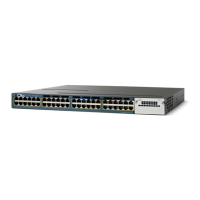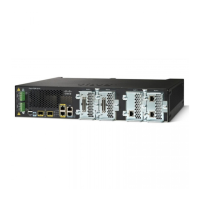29-61
Catalyst 3550 Multilayer Switch Software Configuration Guide
78-11194-09
Chapter 29 Configuring QoS
Configuring Standard QoS
As a result of this configuration, when queue 1 is filled above 10 percent, packets with DSCPs 0, 8, 16,
24, 32, 40, 48, and 56 are dropped. The same packets are dropped when queue 2 is filled above 40
percent, queue 3 above 60 percent, and queue 4 above 80 percent. When the second threshold (100
percent) is exceeded, all queues drop packets with DSCPs 10, 20, 30, 40, 50, and 60.
Configuring WRED Drop Thresholds Percentages
WRED reduces the chances of tail drop by selectively dropping packets when the output interface begins
to show signs of congestion. By dropping some packets early rather than waiting until the queue is full,
WRED avoids dropping large numbers of packets at once.
All packets with DSCPs assigned to the first threshold are randomly dropped when the first threshold is
exceeded. However, packets with DSCPs assigned to the second threshold continue to be queued and
sent as long as the second threshold is not exceeded. Each threshold percentage represents where WRED
starts to randomly drop packets. By default, WRED is disabled.
If you use WRED, you cannot use tail-drop thresholds, and vice versa.
Beginning in privileged EXEC mode, follow these steps to configure the WRED drop threshold
percentage values on Gigabit-capable Ethernet ports:
Command Purpose
Step 1
configure terminal Enter global configuration mode.
Step 2
mls qos Enable QoS on the switch.
Step 3
interface interface-id Enter interface configuration mode, and specify the egress
Gigabit-capable Ethernet interface.
Step 4
wrr-queue random-detect
max-threshold queue-id
threshold-percentage1
threshold-percentage2
Configure WRED drop threshold percentages on each egress queue.
The default, WRED is disabled, and no thresholds are configured.
• For queue-id, specify the ID of the egress queue. The range is 1
to 4, where queue 4 can be configured as the expedite queue. For
more information, see the “Configuring the Egress Expedite
Queue” section on page 29-62.
• For threshold-percentage1 threshold-percentage2, specify the
threshold percentage values. Separate each value with a space. The
range is 1 to 100.
Step 5
exit Return to global configuration mode.
Step 6
interface interface-id Enter interface configuration mode, and specify the ingress
Gigabit-capable Ethernet interface.
Step 7
wrr-queue dscp-map threshold-id dscp1
... dscp8
Map DSCP values to the WRED drop thresholds of the egress queues.
By default, all DSCP values are mapped to threshold 1.
• For threshold-id, specify the threshold ID of the queue. The range
is 1 to 2.
• For dscp1 ... dscp8, specify the DSCP values that are mapped to the
threshold ID. Enter up to eight DSCP values per command.
Separate each value with a space. The range is 0 to 63.

